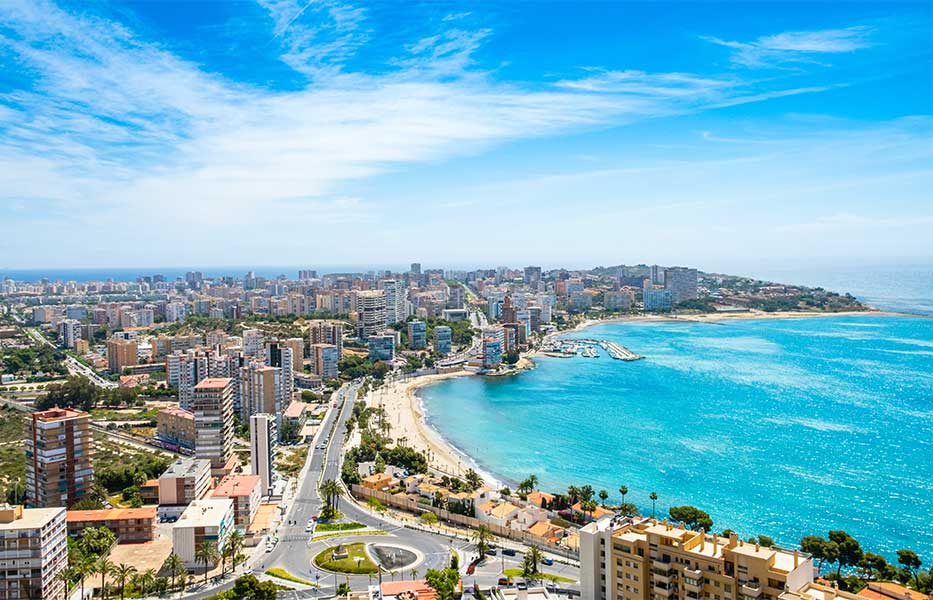
Part 1 – Wider trends, evidence, and findings
Summary
- Spain’s reservoirs have been replenished after one of the wettest winters on record.
- Tourist arrivals are strong, yet local tourism is falling, and overpricing is risking long-term demand.
- Rental regulations are tightening, especially for short-term lets, pushing landlords and buyers into uncertainty.
- Resale properties dominate sales activity; new builds face delays and high construction costs.
- Property prices continue to rise, but locals are increasingly priced out.
- Urban infrastructure is failing to keep up with development and seasonal demand.
- Forecast: Buyer power is increasing in some areas, and policymakers are intervening with mixed results.
Climate conditions & environmental impact on real estate
In January, drought conditions raised serious concerns about Spain’s ability to handle the summer influx of less water-conscious visitors. But one of the wettest winters and early springs in recent memory has replenished reservoirs significantly. While this offers short-term relief, long-term water security remains uncertain as population growth and tourism continue to strain infrastructure.
A time of economic and political transition
Spain is at a turning point—not only in climate but also economically and administratively. In the second half of 2025, the country is now feeling the effects of earlier political reforms, international conflicts, and new tariffs. Regulations affecting the property market and foreign residency permissions are already influencing investment behaviour.
Tourism demand: High arrivals, low satisfaction

Tourists in the Royal Square (Plaça Reial) in Barcelona, Spain
Tourists are arriving in record numbers, according to Málaga and other airport authorities, but hospitality businesses are reporting unexpected vacancies during peak season. While international visitors are increasing, domestic Spanish tourism is declining. Locals may be rejecting the idea of exchanging one crowded, overpriced concrete environment for another. High rental costs and over-commercialisation risk making Spain less attractive for repeat tourists.
Short-term profit, long-term risk
Spain has historically struggled with balancing tourism growth and sustainability. There’s concern that short-term profit motives are again risking the long-term appeal of Spain as a tourist destination. Concrete is concrete, no matter the location—and overbuilding could erode the “escape factor” that attracts visitors and buyers alike.
Property prices, development, and who’s buying
Interest in Spanish property remains strong—from holiday home seekers, investors, remote workers, and citizens of politically unstable countries. Buyers are flocking to Spain as a perceived safe haven, driving high demand for resale properties, especially among families who don’t want to wait 2–3 years for off-plan builds. However, local residents are increasingly priced out, especially as investors outbid them for both homes and rentals. Builders focus on luxury developments, ignoring affordable housing needs.
Housing supply crisis & skills shortage
Despite demand, Spain is not producing enough urban homes for local incomes. Most land, materials, and labour are tied up in high-end developments. Skilled trades are in short supply, delaying projects and inflating costs. The result is a rental and ownership squeeze for ordinary residents.
Rental regulation tightens across Spain
Governments at all levels are reacting. Tens of thousands of tourist rental licences have been rescinded, with more expected to follow. Spain now recognises three key lease types:
Governments at all levels are reacting. Tens of thousands of tourist rental licences have been rescinded, with more expected to follow. Spain now recognises three key lease types:
- Tourist/Short-Term: < 60 days (Andalusia) – Requires regional & national licences
- Seasonal: 1–11 months, not primary residence – Needs formal contract, partial LAU rules
- Long-Term: ≥ 1 year, primary residence – Fully governed by LAU; rent caps apply
Spain’s infrastructure at breaking point
The current infrastructure cannot support year-round demand, let alone peak tourist season.
Key bottlenecks:
- Water supply still depends on outdated reservoirs
- Sewage treatment facilities are overcapacity
- Electricity grids under strain from EVs, AC use, and green transition
- Road networks, especially the coastal A7, are beyond saturation
- While rail connections like the Nerja-Algeciras coastal link remain pipe dreams,
- Malaga pushes forward with metro expansions.
Malaga Airport expansion vs. regional strain

Costa del Sol airport in Malaga, Spain
Málaga airport is undergoing a multi-billion-euro expansion to accommodate millions more passengers. Yet, there’s no parallel plan for improving how tourists move within the region. The EU-Gibraltar agreement could shift some traffic to Gibraltar airport, offloading pressure from Málaga and improving Western Costa del Sol logistics.
Subsidised housing initiatives: Too little, too late?
Municipalities like Málaga are launching public-private partnerships to build affordable housing.
Plans include:
- 1,400–1,700 homes
- Rents capped at €10.06/m²
- Target audience: under-35s,
- Vulnerable populations
- Tenancy cap: 7 years (except for 65+)
- Completion: 2027–2028
But where will people live until then?
Rents and property values surge across Spain
Despite government efforts to stabilise the property market, rental prices have risen sharply. According to Fotocasa, the average rent increased by 14% year-on-year across Spain—including cities, coasts, and inland areas.
Property sales surged 20% in the last six months, reaching levels not seen since the 2007 peak. Resales now dominate the market, especially for smaller investment properties, while new builds are increasingly geared toward higher-end international buyers.
Many landlords are exiting the market due to restrictive regulations, further reducing rental supply. Airbnb’s recent policy to delist unlicensed properties may temporarily limit short-term rental options.
Compulsory registration for tourist rentals
As of July 2025, all tourist rental properties must be listed in a new Central Register in Madrid. Without this registration number, properties cannot legally be marketed.
Key updates:
- Existing regional licences are no longer sufficient.
- Urbanisation communities must approve tourist use by a 60% majority vote.
- Licences are non-transferable upon sale of the property.
This has introduced uncertainty, especially for investors. Communities may reverse decisions at annual AGMs, potentially reducing future rental income and property value.
Relief measures for landlords – but still limited
Landlords are seeing the end of minimum contract terms (5–10 years) under the LAU. As these contracts expire, rents may be raised to market levels—but affordability challenges persist.
In practice, evictions can take up to two years. Many landlords must negotiate with tenants, sometimes accepting below-market rates to avoid costly legal proceedings. Even after winning a case, legal and enforcement fees can eat into profits.
Sustainability rules: Spain’s energy transition challenge

House energy efficiency Spain
Major EU legislation is reshaping energy use in Spanish homes:
- From 2027, oil and gas heating will face a 10–15% surcharge.
- By 2033, all homes must meet a minimum D energy rating.
- By 2035, all fossil fuel heating systems must be replaced.
- By 2050, zero CO₂ emissions will be mandatory.
The scale of this challenge is vast—80% of Spanish homes currently fail to meet the D rating. Retrofitting homes will require skilled labour, funding, and major logistical planning. Solid fuel fireplaces have already been banned for new installs since 2023.
Coastal Law revisions: Ley de Costas
Spain’s Coastal Law is being revised quietly to address rising sea levels and climate risk. The changes aim to protect historic homes and buildings close to the shoreline.
Current regulations allow authorities to demand demolition of any structure within a certain distance of the high water mark. New rules may extend protections but could also render more properties legally vulnerable if coastlines shift.
Who is driving demand?
Digital nomads, remote workers, and lifestyle buyers continue to fuel demand in Spain’s coastal and suburban areas. Professionals are leaving city centres in favour of better quality of life and flexible work setups.
This shift is seen as a long-term structural change, not a temporary post-pandemic trend. As a result, housing prices in traditionally lower-demand zones are climbing, and inventory remains tight in key locations.
Legal duties of estate agents – Know the Law
Estate agents in Andalucia are not yet licensed—but that does not exempt them from legal responsibility. As outlined by Franke y de la Fuente Abogados, agents must:
- Act in good faith – Be honest and transparent (Civil Code)
- Disclose all material facts – Including planning issues and structural defects (Housing Law)
- Provide full, clear information – No delays or vague answers (Consumer Law)
- Avoid misleading advertising – Claims must be accurate (Advertising Law)
- Respect consumer rights – Clients deserve all relevant information before committing (Housing & Consumer Law)
Buying or selling a property: Who covers the risk?
Approximately 85% of a property investment goes into the building and land—not paperwork or admin. Yet this is where most hidden problems occur.
Buyers should:
- Hire a surveyor for structural inspections
- Ensure legal accuracy of deeds and extensions
- Confirm energy rating is compliant
Sellers can also benefit:
- Pre-sale inspections help correct issues early
- Independent reports boost buyer confidence
- Reduces price negotiations and delays
Market valuation insights: Asking vs selling price

Survey Spain tracks the difference between asking and actual sale prices where we have been supplied with that information from reliable sources. These are often from clients for whom we have carried out a building survey/home inspection, and they inform us what price they are actually paying for the property after receiving our report. We can use that information to improve the accuracy of our current market valuations.
Average Difference Between Asking Price and Actual Selling Price.
1st Half of 2024 January to June – 5.69%
A significant fall since the last half year, most probably caused by the shortage of property lessening the negotiating strength of the buyers. It must be remembered that this is an average of all the Regions of Spain in which we are active and varies from -12% to only -1.32%.
2nd Half of 2024 July to December – 7.76% (July to September 7.22% and October to December 8.31%)
A substantial increase since the first half of the year. Considering the reports of the lack of property it is surprising. However, one perhaps uncharitable explanation could be that the advising agencies wanted to see a sale as they needed the fee income and so recommended their clients to accept an offer when in the past, they would have continued the negotiations to try to obtain a higher price.
1st Half of 2025 January to June – 8.76%
We had fewer records to work with, but noted that the first quarter, January to March was a substantially bigger difference than the 2nd quarter. Again, asking prices can be inflated and given the comments indicating that perhaps price rises were due to have peaked for now, that would allow for the smaller % in the 2nd quarter as agents and sellers saw substantial discounts being given by others to achieve a sale. Certainly, we have received many more indications from selling agents that prices have reduced in order to get a quick sale.
Resales Online Snapshot – Costa del Sol (Aug 2025)
- 11,176 properties listed (≥ €100K) – stable vs January
- 3,659 (33%) priced over €1M – up 8% from Jan
- 392 new builds – 70% increase from Jan
- 796 (60%) rentals priced ≥ €2,500/month – up from 49%
- Only 9.3% of short-term listings show licence numbers – down from 11.7%
Expect stricter enforcement and possible removals of unlicensed properties from platforms soon.
Final analysis and outlook
The market is undergoing a shift:
- Prices remain high, but buyer leverage is returning
- Rental regulation and energy laws will reduce speculative buying
- Institutional buyers may enter social housing more heavily
2025 will likely close as a transition year, with clearer market segmentation between local-use, lifestyle buyers, and yield-seeking investors.




